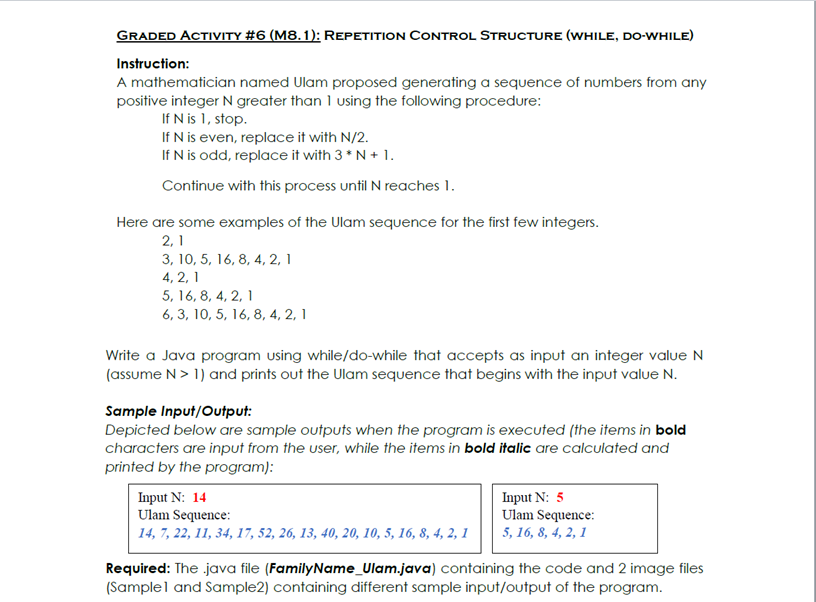GRADED ACTIVITY #6 (M8.1): REPETITION CONTROL STRUCTURE (WHILE, DO-WHILE) Instruction: A mathematician named Ulam proposed generating a sequence of numbers from any positive integer N greater than 1 using the following procedure: If N is 1, stop. If N is even, replace it with N/2. If N is odd, replace it with 3 * N + 1. Continue with this process until N reaches 1. Here are some examples of the Ulam sequence for the first few integers. 2, 1 3, 10, 5, 16, 8, 4, 2, 1 4, 2, 1 5, 16, 8, 4, 2, 1 6, 3, 10, 5, 16, 8, 4, 2, 1 Write a Java program using while/do-while that accepts as input an integer value N (assume N> 1) and prints out the Ulam sequence that begins with the input value N. Sample Input/Output: Depicted below are sample outputs when the program is executed (the items in bold characters are input from the user, while the items in bold italic are calculated and printed by the program): Input N: 14 Ulam Sequence: 14, 7, 22, 11, 34, 17, 52, 26, 13, 40, 20, 10, 5, 16, 8, 4, 2, 1 Input N: 5 Ulam Sequence: 5, 16, 8, 4, 2, 1 Required: The java file (FamilyName_Ulam.java) containing the code and 2 image files (Samplel and Sample2) containing different sample input/output of the program.
GRADED ACTIVITY #6 (M8.1): REPETITION CONTROL STRUCTURE (WHILE, DO-WHILE) Instruction: A mathematician named Ulam proposed generating a sequence of numbers from any positive integer N greater than 1 using the following procedure: If N is 1, stop. If N is even, replace it with N/2. If N is odd, replace it with 3 * N + 1. Continue with this process until N reaches 1. Here are some examples of the Ulam sequence for the first few integers. 2, 1 3, 10, 5, 16, 8, 4, 2, 1 4, 2, 1 5, 16, 8, 4, 2, 1 6, 3, 10, 5, 16, 8, 4, 2, 1 Write a Java program using while/do-while that accepts as input an integer value N (assume N> 1) and prints out the Ulam sequence that begins with the input value N. Sample Input/Output: Depicted below are sample outputs when the program is executed (the items in bold characters are input from the user, while the items in bold italic are calculated and printed by the program): Input N: 14 Ulam Sequence: 14, 7, 22, 11, 34, 17, 52, 26, 13, 40, 20, 10, 5, 16, 8, 4, 2, 1 Input N: 5 Ulam Sequence: 5, 16, 8, 4, 2, 1 Required: The java file (FamilyName_Ulam.java) containing the code and 2 image files (Samplel and Sample2) containing different sample input/output of the program.
Database System Concepts
7th Edition
ISBN:9780078022159
Author:Abraham Silberschatz Professor, Henry F. Korth, S. Sudarshan
Publisher:Abraham Silberschatz Professor, Henry F. Korth, S. Sudarshan
Chapter1: Introduction
Section: Chapter Questions
Problem 1PE
Related questions
Question

Transcribed Image Text:GRADED ACTIVITY #6 (M8.1): REPETITION CONTROL STRUCTURE (WHILE, DO-WHILE)
Instruction:
A mathematician named Ulam proposed generating a sequence of numbers from any
positive integer N greater than 1 using the following procedure:
If N is 1, stop.
If N is even, replace it with N/2.
If N is odd, replace it with 3 * N + 1.
Continue with this process until N reaches 1.
Here are some examples of the Ulam sequence for the first few integers.
2, 1
3, 10, 5, 16, 8, 4, 2, 1
4, 2, 1
5, 16, 8, 4, 2, 1
6, 3, 10, 5, 16, 8, 4, 2, 1
Write a Java program using while/do-while that accepts as input an integer value N
(assume N> 1) and prints out the Ulam sequence that begins with the input value N.
Sample Input/Output:
Depicted below are sample outputs when the program is executed (the items in bold
characters are input from the user, while the items in bold italic are calculated and
printed by the program):
Input N: 14
Ulam Sequence:
Input N: 5
Ulam Sequence:
5, 16, 8, 4, 2, 1
14, 7, 22, 11, 34, 17, 52, 26, 13, 40, 20, 10, 5, 16, 8, 4, 2, 1
Required: The java file (FamilyName_Ulam.java) containing the code and 2 image files
(Samplel and Sample2) containing different sample input/output of the program.
Expert Solution
This question has been solved!
Explore an expertly crafted, step-by-step solution for a thorough understanding of key concepts.
This is a popular solution!
Trending now
This is a popular solution!
Step by step
Solved in 4 steps with 3 images

Knowledge Booster
Learn more about
Need a deep-dive on the concept behind this application? Look no further. Learn more about this topic, computer-science and related others by exploring similar questions and additional content below.Recommended textbooks for you

Database System Concepts
Computer Science
ISBN:
9780078022159
Author:
Abraham Silberschatz Professor, Henry F. Korth, S. Sudarshan
Publisher:
McGraw-Hill Education

Starting Out with Python (4th Edition)
Computer Science
ISBN:
9780134444321
Author:
Tony Gaddis
Publisher:
PEARSON

Digital Fundamentals (11th Edition)
Computer Science
ISBN:
9780132737968
Author:
Thomas L. Floyd
Publisher:
PEARSON

Database System Concepts
Computer Science
ISBN:
9780078022159
Author:
Abraham Silberschatz Professor, Henry F. Korth, S. Sudarshan
Publisher:
McGraw-Hill Education

Starting Out with Python (4th Edition)
Computer Science
ISBN:
9780134444321
Author:
Tony Gaddis
Publisher:
PEARSON

Digital Fundamentals (11th Edition)
Computer Science
ISBN:
9780132737968
Author:
Thomas L. Floyd
Publisher:
PEARSON

C How to Program (8th Edition)
Computer Science
ISBN:
9780133976892
Author:
Paul J. Deitel, Harvey Deitel
Publisher:
PEARSON

Database Systems: Design, Implementation, & Manag…
Computer Science
ISBN:
9781337627900
Author:
Carlos Coronel, Steven Morris
Publisher:
Cengage Learning

Programmable Logic Controllers
Computer Science
ISBN:
9780073373843
Author:
Frank D. Petruzella
Publisher:
McGraw-Hill Education